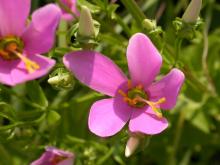Wildflowers, Grasses and Other Nonwoody Plants
Media

Species Types
Scientific Name
Verbascum thapsus
Description
Mullein immigrated to America along with Europeans, and with them it has spread across the continent. Its fuzzy, green-gray rosettes of leaves and tall spikes of yellow flowers make it easy to identify.
Media

Species Types
Scientific Name
Verbascum blattaria
Description
Moth mullein is a native of Eurasia introduced to our continent in the early 1800s. Since then, it has spread across North America. It’s named because the fuzzy flower, with 2 antennalike stamens, looks something like a moth.
Media

Species Types
Scientific Name
Ruellia strepens
Description
Although the funnel-shaped, 5-lobed flowers look something like the petunias you find at garden centers, our wild petunia is not related to them. This ruellia often has crinkled hairs in 2 narrow, lengthwise bands on opposite sides of the stalk.
Media

Species Types
Scientific Name
Ludwigia peploides
Description
Water primrose is a common shoreline plant with bright yellow flowers and long, trailing stems. It grows in dense mats in the shallow areas of ponds, lakes, and streams.
Media

Species Types
Scientific Name
Sabatia angularis
Description
Rose-pink, or rose gentian, is a delicately scented native wildflower with floral clusters resembling candelabras. It has square stems and clasping leaves. It is common in open Ozark woods and fields and blooms June–September.
Media

Species Types
Scientific Name
Monotropa hypopitys
Description
Pinesap is a plant that puts the "wild" in wildflower! It lacks chlorophyll, so its roots connect to fungi underground and absorb nutrients from the fungi.
Media

Species Types
Scientific Name
Monotropa uniflora
Description
Indian pipe lacks chlorophyll, so it is white, not green. Below ground, its roots join with fungi that connect to tree roots. This plant, then, takes nourishment indirectly from the trees.
Media

Species Types
Scientific Name
Silene stellata
Description
A member of the pink or carnation family, starry campion has fringed, white petals that give it a starry appearance. It blooms from June to September in dry, wooded uplands and slopes.
Media

Species Types
Scientific Name
Saponaria officinalis
Description
Soapwort is a tall, showy wildflower that has chemicals in its sap that lather up like soap. Native to Eurasia, it has been introduced worldwide and is a common roadside wildflower.
Media

Species Types
Scientific Name
Dianthus armeria
Description
Deptford pink has straight, strong, narrow stems that bear small clusters of pink flowers with white dots. Common statewide in sunny, open locations such as pastures and roadsides.
See Also
About Wildflowers, Grasses and Other Nonwoody Plants in Missouri
A very simple way of thinking about the green world is to divide the vascular plants into two groups: woody and nonwoody (or herbaceous). But this is an artificial division; many plant families include some species that are woody and some that are not. The diversity of nonwoody vascular plants is staggering! Think of all the ferns, grasses, sedges, lilies, peas, sunflowers, nightshades, milkweeds, mustards, mints, and mallows — weeds and wildflowers — and many more!





















